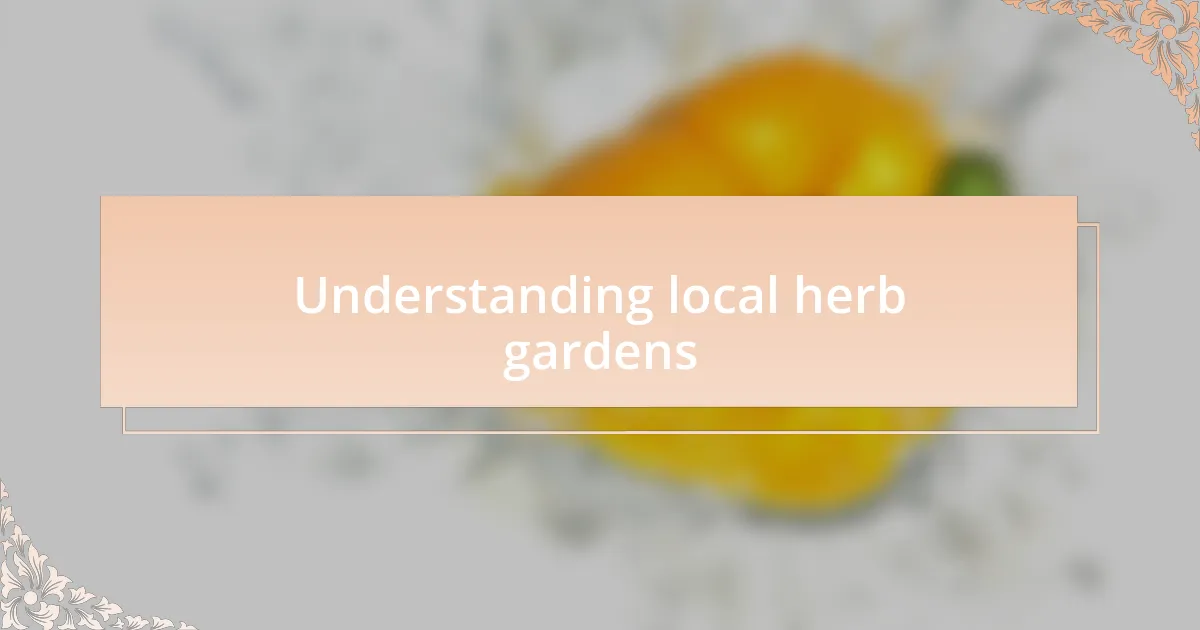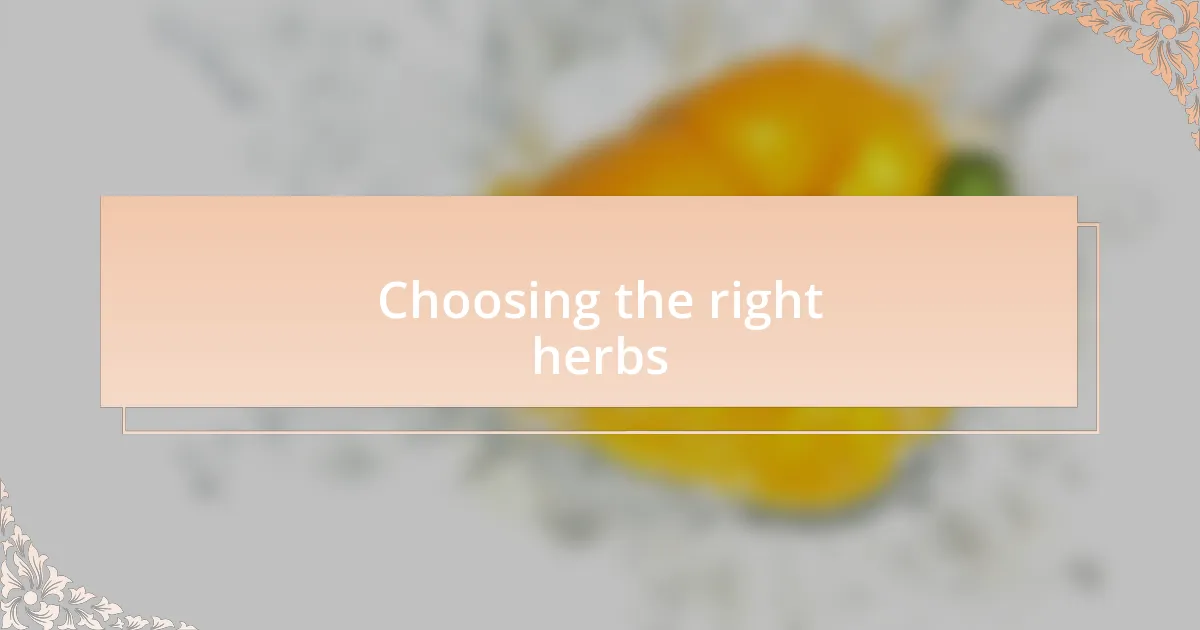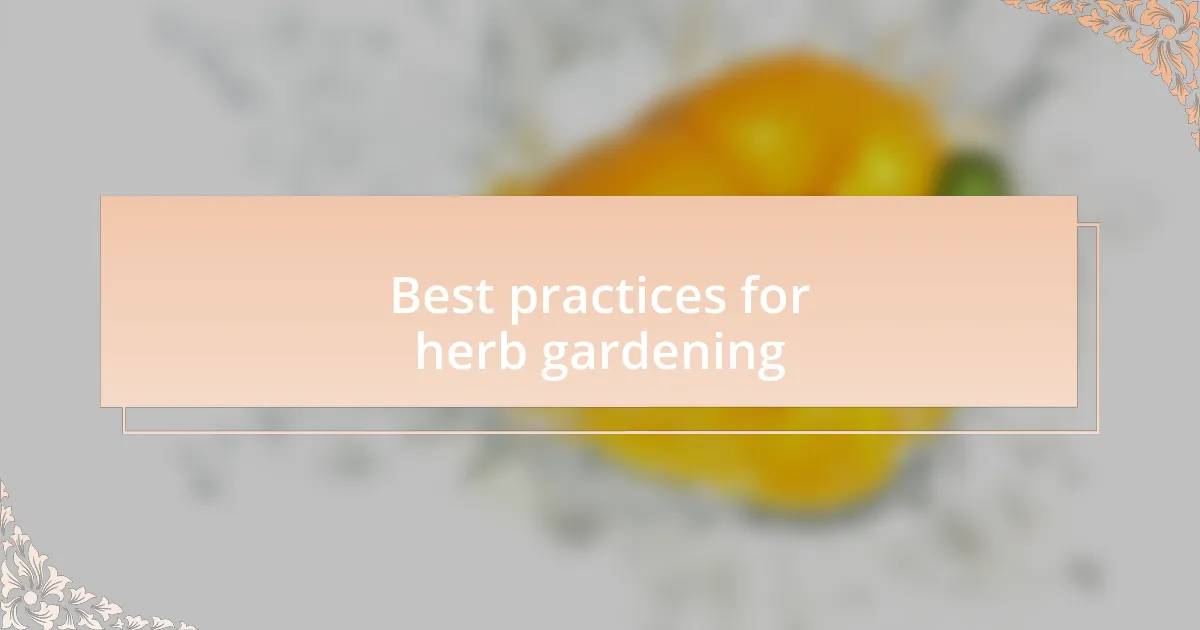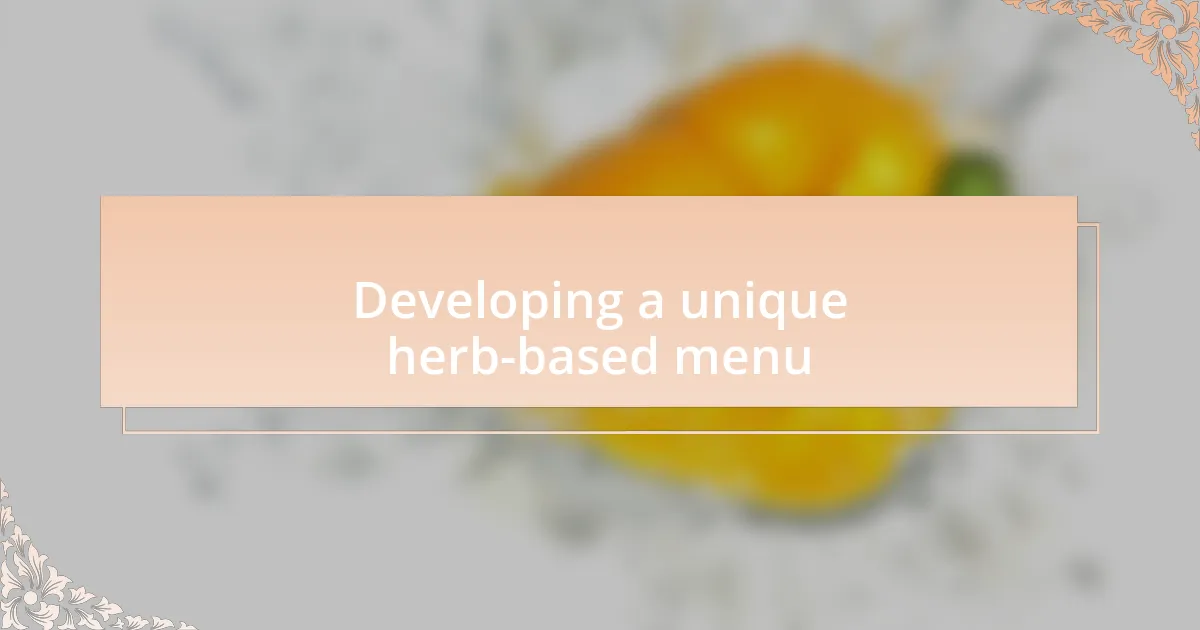Key takeaways:
- Local herb gardens enhance cooking by providing fresh flavors and a deeper connection to nature.
- Choosing the right herbs based on climate and dish requirements is essential for successful gardening and culinary enhancement.
- Best practices for herb gardening include proper spacing, mindful watering, and timing the harvest for peak flavor.
- Experimenting with unique herb pairings can lead to delightful surprises and creative culinary experiences.

Understanding local herb gardens
Local herb gardens are a treasure trove for anyone who loves cooking. I remember the first time I grew my own basil; the fragrance that filled my kitchen transported me straight to Italy. Have you ever considered how fresh herbs can elevate a simple dish? They really do add that extra flair.
Creating a local herb garden is not just about the plants; it’s also about fostering a connection with nature. There’s a certain serenity in watching your herbs grow, knowing that you’re nurturing them with your own hands. Have you felt that moment of joy when you harvest your first bunch? It’s incredibly rewarding and brings an intimate touch to your cooking.
Understanding the right herbs to grow for your climate and culinary needs can transform your gardening experience. I learned this the hard way when I tried to grow mint in a shaded spot—it just didn’t thrive. What has been your experience with selecting herbs? Choosing the right varieties not only enhances your dishes but also makes gardening much more satisfying.

Importance of herbs in cooking
Herbs are not just an afterthought in cooking; they play a crucial role in defining the flavors of a dish. I vividly recall a time when I made a simple roasted chicken. I garnished it with fresh thyme and rosemary from my garden, and the aroma that filled my kitchen was simply divine. Just imagine how a sprinkle of fresh herbs can transform bland meals into culinary masterpieces!
The beauty of using fresh herbs is their ability to brighten dishes without overwhelming them. I once made a pasta dish that looked lovely but tasted lackluster until I added a handful of freshly chopped parsley. It was like giving the meal a little wake-up call! Have you ever experienced that transformative moment when a herb elevates a dish from ordinary to extraordinary?
Incorporating herbs into your cooking not only enhances flavor but also adds nutritional benefits. For instance, I’ve found that using cilantro in my salsa not only gives it a fresh taste but also packs in vitamins and minerals. Isn’t it fascinating how a few leaves can add both health benefits and a burst of flavor? Each herb has its unique profile, inviting us to educate ourselves about their potential.

Choosing the right herbs
Choosing the right herbs is all about considering what flavors harmonize with your dishes. I remember once standing in my garden, unsure of which herbs to pick for my signature guacamole. My instinct led me to cilantro, and the burst of freshness it provided made all the difference, enhancing the creamy avocado beautifully. Have you ever felt that excitement when the right herb transforms your dish?
When selecting herbs, it’s also essential to think about the climate and conditions of your garden. I learned this the hard way when I planted basil in a shady spot; it wilted instead of thriving. Choosing herbs that suit your environment not only ensures they flourish but also gives you a constant supply for your kitchen adventures. Isn’t it rewarding to harvest herbs right from your own garden?
Lastly, consider the flavor profiles you want to highlight. Some herbs, like mint, can add an unexpected twist to a dish. I once added fresh mint to a fruit salad, thinking it wouldn’t make much of a difference, and the refreshing hint completely elevated the flavor. What herbs are you curious to experiment with, knowing they could introduce a new favorite dish?

Best practices for herb gardening
Best practices for herb gardening revolve around nurturing your plants with the right care. I remember when I first started out, I was so eager to grow a variety of herbs that I overlooked the importance of spacing. Planting them too close together stunted their growth and made it hard for them to thrive. Have you ever watched a crowded garden slowly struggle? Ensuring adequate space allows each herb to soak up the sun and air it needs, leading to a more abundant harvest.
Watering is another crucial aspect that deserves attention. I learned early on that it’s not just about how much you water, but also how often. My initial mistake was thinking daily watering was the key, but I quickly discovered that most herbs prefer the soil to dry out a bit between sessions. This responsibility of being attuned to your plants’ needs keeps you engaged. When was the last time you truly connected with your garden?
Finally, consider the timing of your harvest. I often found myself picking herbs too early, missing out on their full flavor potential. Once, I let my rosemary reach its peak before snipping, and the increase in aroma was simply astounding. It’s a small change that requires patience, but it’s so rewarding. How do you know when your herbs are ready to shine in your kitchen? Trust your senses—you’ll know when they’re at their best.

Personal experiences with local herbs
As I began experimenting with local herbs in my garden, I discovered the magic of basil. There was a moment when I plucked a few leaves and brought them inside; the fresh aroma instantly transformed my kitchen. Have you ever noticed how a single herb can elevate a dish? That experience made me realize how essential local herbs are to enhancing flavors in my cooking.
One summer, I dived into growing thyme, and I was captivated by its resilience. Even amid a heatwave, these little plants thrived, teaching me a lesson in perseverance. The first time I used my homegrown thyme in a roasted chicken recipe, I felt a wave of pride. It was more than just a meal; it was a celebration of my hard work. Do you have a favorite herb that has left a mark on your culinary journey?
Then there was my adventure with mint, which was truly eye-opening. I planted a few sprigs, thinking they would simply complement my dishes, yet they took over like they were on a mission. It was a delightful chaos. I made refreshing drinks that summer, savoring the cool bursts of flavor with each sip. Has a plant ever surprised you in such a delightful way? For me, that overabundance turned into a season of creativity, inspiring me to explore new cocktail recipes.

Developing a unique herb-based menu
Crafting a unique herb-based menu starts with understanding the essence of each herb. I recall my first experience with dill; its distinct anise-like taste added a surprising twist to my potato salad. Have you ever paired an unexpected herb with a familiar dish? It can transform not just flavors, but even the way you view a recipe.
When I began incorporating rosemary into my dishes, I was struck by its bold characteristics. One evening, while making a simple focaccia, I replaced standard toppings with fresh rosemary and sea salt. The resulting bread was not just a side; it was a conversation starter, inviting guests to savor the journey from a humble garden to their plates. How does the presence of a unique herb change your dining experience?
I’ve learned that experimentation leads to the most delightful surprises. I once decided to create a pesto using not just the usual basil but also some zesty cilantro. The vibrant flavor was so unexpected that it inspired a whole new dish. Have you considered how slight changes in your ingredient choices could spark culinary creativity? Embracing these local herbs has opened up a world where each dish tells its own story, a journey from garden to table.